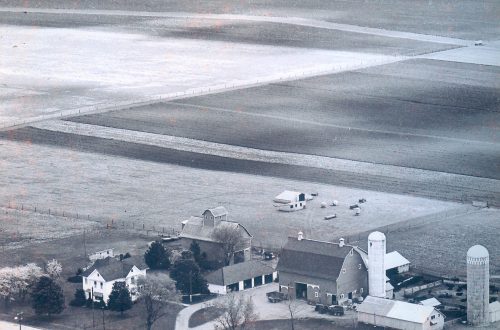
The Future of Farming
When you sit down to your Thanksgiving dinner, I hope you will consider saying a big “thank you” to the farmers and ranchers responsible for your meal. As Americans, we have a huge gap in understanding what’s happening out there in rural areas. I’ve thought about it a lot since a recent visit to my own family farm located in the middle of our country’s breadbasket. The life and methods on those farms have changed considerably in the past half century.
When I was growing up there in the 1950s, most farms in the area fattened cattle and hogs on the corn that was grown in the fields. In the 1970s, that life was threatened by changing customer tastes and larger feedlots and hog operations. The Union Stockyards in Chicago, the site that made the city the meatpacking center for the country, closed in 1971. Soon after, my father decided that it made no sense to put seven pounds of corn through a steer just to add a pound of beef. Not to mention that it was less work just to raise corn and soybeans and sell them directly. Less work; less risk. It was happening to many of the other farms all over.
Mechanization
A major contributor to that change was farm machinery, particularly the tractor. It was just after World War II that half of American farms had a tractor – the other still farmed with horses. And since the mid-20th century, the combine that harvests the crops has matured from a towed device to a self-propelled machine armed with computers that can drive itself. Those changes have removed the toil of harvesting and taken away jobs. Where corn was once harvested by hand, requiring weeks by many hands to bring in the crop, today’s harvesters can harvest about 75 acres in a day.
A lot of paying jobs are gone from the farm belt. When my grandfather ran the farm, he employed countless farmhands over the years. Those jobs – gone. The trucker who transported cattle and hogs to market – gone. The man whose truck-mounted corn sheller served local farms – gone. The college kids employed in the summer during the local pea harvest for Del Monte – gone. Del Monte’s vegetable packing plant – gone. Several small farm-implement dealers – gone. The list goes on.
Capital demands
Farming has always been capital-intensive, cash-illiquid, and a dirty business that often requires 12- to 15-hour days, six or seven days a week. Prices for farm produce have not kept up with inflation, and we, as consumers, are benefitting. But that comes at a price. First, one of those combines costs between $350,000 and $500,000 without any add-ons. A new John Deere tractor is going to run you between $150,000 and $500,000. And the good farmland in our area is going for more than $10,000 per acre.
What all this means is that today’s farmers in our area of the corn belt need 1,200 to 1,500 acres to make the numbers work. When I was in high school, the average farm size in the area was 320 acres. Most “family farms” survive because the farmers and spouses have outside jobs. The U.S. Department of Agriculture reports that small family farmers depended most on off-farm income to make a go of it. America has just over two million farms, and 80,000 generate two-thirds of farm production. Funding from Wall Street is buying up large tracts of farmland for big operations.
Farmers themselves are getting older: the average farmer is now aged almost 60 years, according to the latest census from the Department of Agriculture. The average age was 50.3 in 1978. Thanks to mechanization, farmers don’t need to retire, but they often don’t have a family member interested in taking over.
Bottom line: If you want to quit your day job and take up growing corn and soybeans, you’ll need access to close to $15 million. The children of farmers who do remain in the community usually can’t afford to take over the family business. Most, like me, fled early to urban environs where it’s easier, safer, and cleaner to make a living.
The future of food
Long-term, I think that farmers and the agriculture sector need to begin a serious discussion with policy-makers if we are going to continue to expect agriculture to feed the world. That would include a plan to preserve agricultural land and to find a way to support farmers and farming communities. In the short term, please join me in giving thanks to the farmer who puts the food on our tables.
To comment, please click on “Read in Browser” or on the headline to view the blog on the website. You can log in and comment at the end of the blog to share your thoughts and start a discussion.
If you’d like to share the blog, click on the Facebook icon or one of the others. Thanks!





4 Comments
Tom Stites
Wonderful story, so wonderful that I forwarded it to two people: a friend who grew up in Quincy, Ill., and who sold the family farm after his father died a few years ago, and a nephew in his 20s who is a John Deere mechanic at a huge dealership in Idaho. I’m sure both will grin from ear to ear as they read it, as I did. Thank you.
Stephen Brayton
Re. loss of trucker jobs in hauling hogs to market: What transportation needs remain in the cycle, e.g. feedlot-slaughter house? Does rail have any role left; e.g. transporting the finished product to supermarket warehouses?
judy schmid
This is a subject that could take hours to discuss. I have watched a family farm disappear also. It has all the negitives you mention but in some way there are still people who want to work close to the land, as their own boss. They seem to have a simple, quiet life, usually in a close knit community.
Different strokes for different folks!
Tracy May
Thanks for a great story, Farmboy! And a big thank you to our farmers!
In response to the “The future of food” section of your story, I believe there is hope. Over the 12 years I worked at CHS, I developed a more in-depth understanding of the challenges farmers face today. Yes, CHS is big business but it’s a cooperative, which means it’s owned by farmers, ranchers and local cooperatives and governed by them as well. The CHS Government Affairs team frequently travels to Washington, D.C. to educate policymakers about the impact of government legislation, rules and regulations and to advocate on behalf of farmers, ranchers and rural communities to ensure their voice is clearly heard. CHS also invests in programs that develop new generations of ag leaders, promote ag safety and strengthen hometown communities.
There are more than 10,000 dedicated employees at CHS who work hard every day to support farmers and their families. Until I retired in 2020 I was one of those employees. I encourage anyone interested in CHS and the future of farming to poke around its website to learn more http://www.chsinc.com.